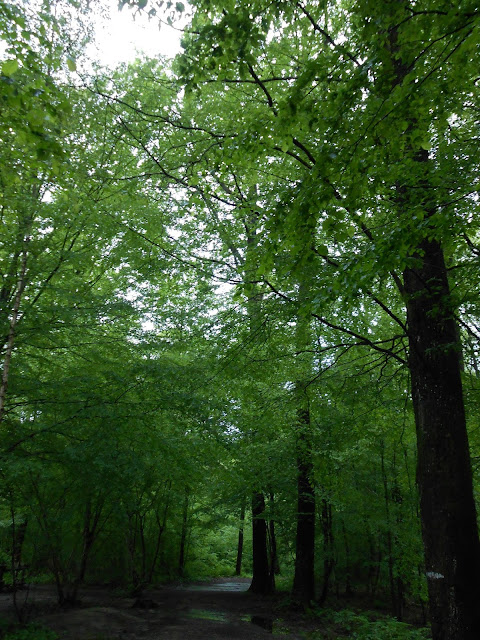The wet weather here has in no way let up, so I decided to see what all this rain looks like in the wilds. The Forest of Verzy is not far from Reims and its key attraction, the
Faux (beech trees) do indeed look just as striking in the summer months, in full folliage, as they do during the barren
winter period.
They just happen to be a little harder to locate when covered in a very green cloak of leaves!
The
Faux domaine is said to be set in the gardens of an early abbey, from the 7th century, itself marking the site where a certain Lorrain evangelist, Saint Basle, had lived as a hermit.
Nothing remains today of this edifice that was destroyed during the Revolution years. The only link back to these origins are these strangely twisted, dwarf trees themselves -
les faux - which may initially have come from the Lorraine region of France.
Indeed, apart from the relative wealth of
Faux here in Verzy, this natural phenomenon is to be found in very few places around Europe (near Hanover in Germany and Malmö in Sweden).
In spite of scientific research, the actual emergence of these trees remains somewhat a mystery, although a similar process of growth can be seen in certain forms of oak and chestnut.
A unique genetic composition is at the source of the phenomenon, but the
tortillard effect is not always transmitted by seed (
les faïnes) , of which few are fertile. Reproduction is also carried out by the formation of runners (
le marcottage), which means that branches (
les marcottes) grow out along the forest floor, taking root and creating off-shoot
Faux, rather like ivy or honeysuckle.
 |
| The more usual trees... |
Alternatively, a new
Fau may grow from the formation of a long-running root (
le drageonnage), which finally gains autonomy as a
drageon from the parent tree.
 |
| Very wet underfoot! |
Of course, there have been suggestions that the
Faux are in fact fairy trees. Hmm... Well, what certainly was magical, was the effect of all that greenery, dripping with water.
Mosses, unfurled bracken, ferns and fungi...
All vying for space on the forest floor.
It's amazing how many shades of colour can be incorporated in the humblest form of 'greenery'.
Some of these growing forms looked like strange frilled flowers, or even frost...
These really were distinctly soggy, but still beautiful...
As were some of the local inhabitants, in their own slimy, soggy right!
Then, of course, there were the more traditional forms of flowering beauty...
And finally those majestic ferns, with their branched forms that just remind me of flying buttresses on Gothic cathedrals...























